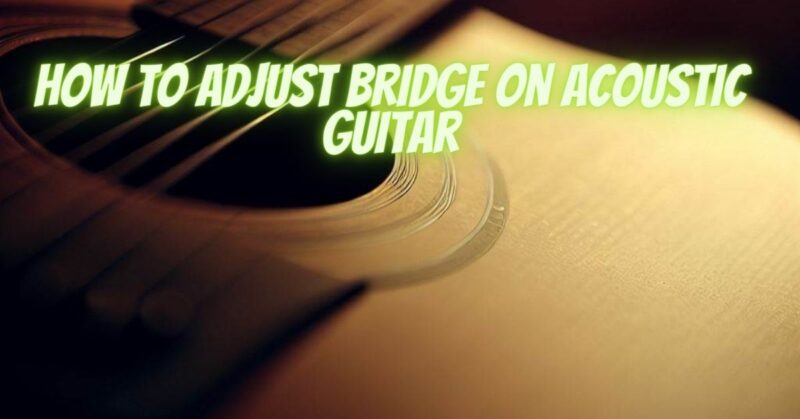The bridge of an acoustic guitar plays a crucial role in transmitting the strings’ vibrations to the guitar’s body, ultimately shaping the instrument’s tone and playability. Properly adjusting the bridge ensures that your guitar produces clear, resonant sounds with comfortable string action. Whether you’re experiencing buzzing strings, high action, or you simply want to fine-tune your guitar’s setup, learning how to adjust the bridge on an acoustic guitar can be beneficial. In this article, we will guide you through the steps to adjust the bridge to achieve the best possible playability and sound.
- Assess the Bridge Height
Before making any adjustments, it’s essential to evaluate the current bridge height and its impact on your guitar’s playability. If the action (the height of the strings above the fretboard) is too high, you may experience difficulty fretting notes and a lack of comfort while playing. Conversely, if the action is too low, you might encounter fret buzz, where the strings rattle against the frets when played.
- Loosen the Strings
To adjust the bridge, you’ll need to relieve the tension on the strings. Loosen all the strings by turning the tuning pegs until the tension is adequately reduced. You don’t need to remove the strings entirely; just enough to allow adjustments without putting unnecessary strain on the guitar’s neck and top.
- Locate the Bridge Adjustment Point
Most acoustic guitars feature a belly-up bridge, meaning the bridge curves away from the guitar body, creating a slight belly shape. This type of bridge usually has a saddle that can be adjusted to alter the action. The saddle is a small piece of bone, plastic, or other material that sits in a slot on the bridge, holding the strings at the correct height.
- Adjusting the Action
To lower or raise the action, use sandpaper or a small file to shave down or build up the bottom of the saddle. To lower the action, sand the bottom of the saddle evenly, ensuring that it remains flat and level. If you need to raise the action, add a thin strip of material (often found in guitar repair kits) under the saddle. Make sure to keep the bottom of the saddle flat on the material.
- Check Intonation
Intonation is crucial for ensuring accurate pitch along the entire length of the fretboard. To check intonation, play the open string and then play the same string at the 12th fret. The two notes should be precisely an octave apart. If the notes are sharp or flat, use a small screwdriver to adjust the saddle position forward or backward slightly until the intonation is correct.
- Recheck and Fine-Tune
After making the necessary adjustments, tune the guitar back to pitch and check the action and intonation once more. Play each string at various frets to ensure that there are no buzzing sounds and that the guitar is easy to play across the entire neck.
- Repeat if Necessary
Guitar setup is often a process of trial and error. If you’re not satisfied with the initial adjustments, don’t hesitate to repeat the steps and make further adjustments until you achieve the desired playability and tone.
Adjusting the bridge on an acoustic guitar can significantly improve its playability and sound. By taking the time to evaluate the action, make adjustments to the saddle, and fine-tune the intonation, you can optimize your guitar’s setup for a more comfortable and enjoyable playing experience. If you’re uncertain about making adjustments yourself, don’t hesitate to seek the assistance of a professional guitar technician, as they can provide expert guidance and ensure your guitar is set up to its full potential. Remember that a well-adjusted bridge can enhance the overall performance of your acoustic guitar and bring out its true potential.


